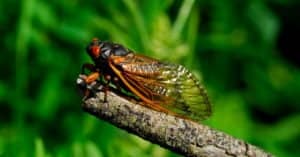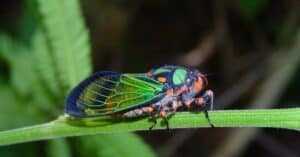It’s about to be noisy, especially in the Midwest. Two broods of periodical cicadas are preparing to emerge from their slumber simultaneously. And in select areas, they are coming together to provide a rare, once-in-a-lifetime spectacle that hasn’t been witnessed in 221 years. In fact, this year’s spring cicada emergence is set to be the largest since 1803, when Thomas Jefferson was our President.
Why This Year’s Spring Cicada Emergence Will Be So Large

2024 presents a unique opportunity for cicada enthusiasts.
©Nicole Glass Photography/Shutterstock.com
We see cicadas every year, you may be saying to yourself. What makes this year any different? The regular summer season cicada emergence we experience is from annual cicadas, usually making their presence known and music heard from July through September. While that will still happen, 2024 brings the addition of two broods of periodical cicadas. Periodical cicadas are those that only emerge every 13 or 17 years, depending on their brood. The timetable for the emergence of these two broods just happens to coincide this year, meaning they will all emerge from their burrows simultaneously. This year’s spring cicada emergence is set to be the largest, loudest, and most raucous group in 221 years, dating back to 1803. And all they want to do is mate and lay more eggs.
Where the Cicadas Will Be Most Numerous

Springfield, Illinois, is projected to have the highest cicada population during 2024’s emergence.
©Jacob Boomsma/Shutterstock.com
Brood XIX, the 13-year brood, features four species. They emerge in mid-May and last through late June. This brood is found in parts of many Southeast and Midwest states, including:
- Alabama
- Arkansas (Northwest)
- Georgia (Northwest)
- Illinois (Southern)
- Iowa (Southeast)
- Indiana (Southwest)
- Kentucky (Western)
- Louisiana (Northern)
- Maryland (St. Mary’s County)
- Mississippi
- Missouri
- North Carolina (Central)
- Oklahoma (Eastern)
- South Carolina (Western)
- Tennessee
- Virginia (Eastern)
Brood XIII, the 17-year brood, features three species. It emerges in the same time frame in five Midwestern states, including:
- Illinois (Northern)
- Indiana
- Iowa (Eastern)
- Michigan (Lake Michigan)
- Wisconsin (Southern)
Looking at the list of states, we see a location overlap of Illinois, Indiana, and Iowa, making these states the places where the cicada numbers should be strongest. Within that area, Sangamon County in Springfield, Illinois, seems to be the most likely spot for maximum cicada presence, with surrounding areas seeing a smaller amount of overlap as the distance grows. This simultaneous emergence of cicada broods is a rare occurrence, not scheduled to happen again until 2245.
What To Expect During This Year’s Spring Cicada Emergence
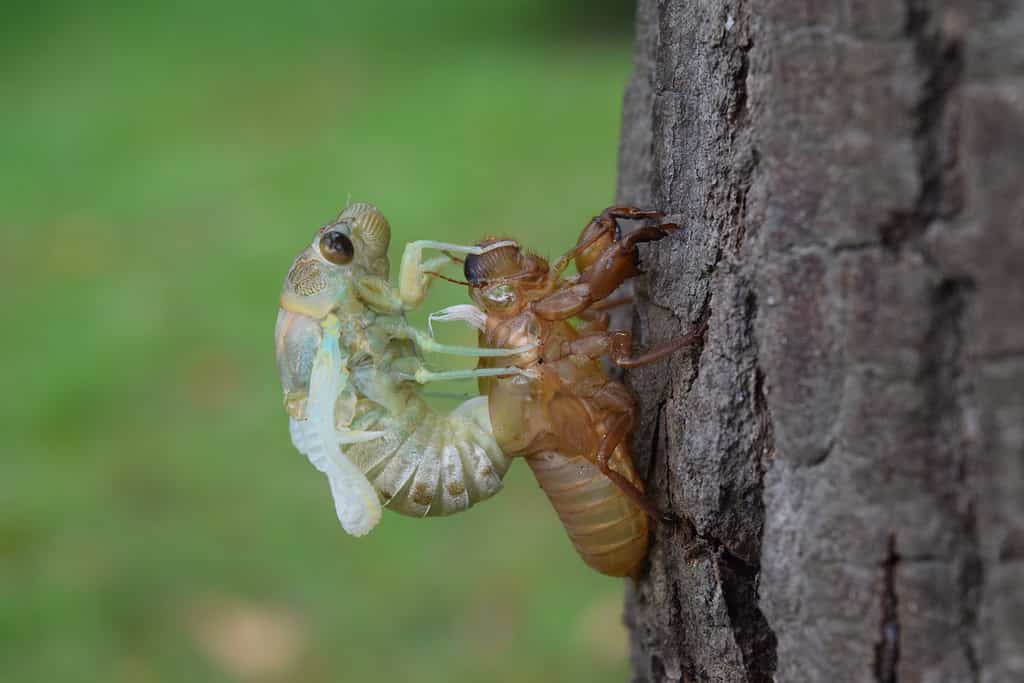
After emerging, cicadas exit their protective exoskeleton before starting the mating process.
©tienduc1103/Shutterstock.com
So, what’s going to happen? What can you expect? It’s important to note that there will not be widespread overlap causing abnormal densities of cicadas. The farther away from Springfield, Illinois, you are, the less likelihood of overlap occurs. But because the two broods are emerging simultaneously, there will be more cicadas emerging in more places than in a normal annual cycle. Cicadas are routinely described as both annoying and fascinating due to their noisy disposition and unique habit of leaving their transparent exoskeleton hanging on plants, trees, window screens, and more. They emerge when the ground temperature hits 64° at 8 inches depth, so depending on the area and climate, the emergence can come in waves throughout the season. Once above ground, you will start to discover their discarded exoskeletons, hear their buzz, and recognize their unmistakable songs.
Cicada Facts (And Benefits)
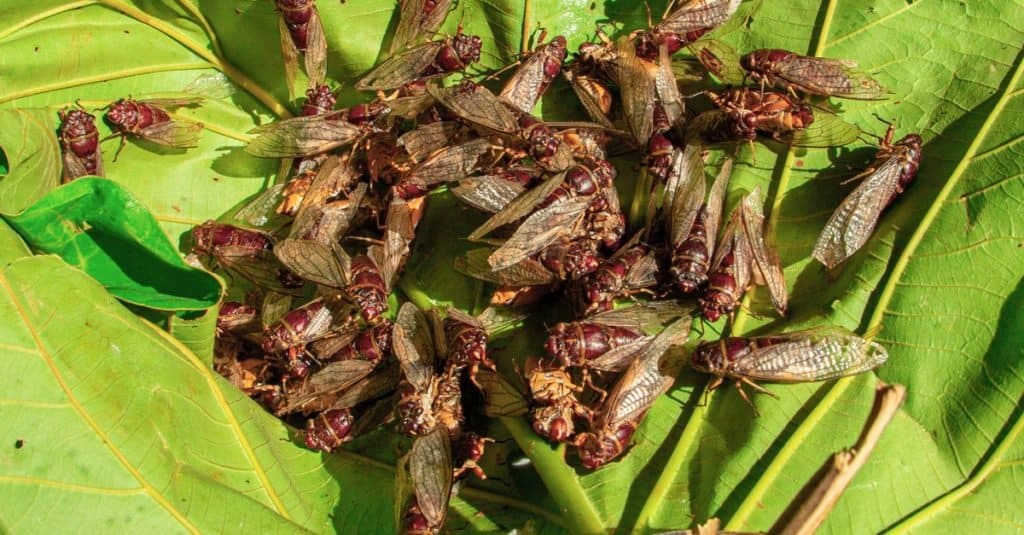
A group of Cicadas is known as a brood. In the United States, these broods have been given letter names according to their life cycle and which years they will hatch.
©iStock.com/Photour1904
- Only male cicadas produce sound, rubbing membranes together at the base of the abdomen.
- There are different sounds for different situations and circumstances encountered by the cicada.
- The two emerging broods of cicadas are considered the loudest of their species, able to reach levels of 106.7 decibels, higher than a standard lawnmower, motorcycle, or jackhammer. With millions, maybe trillions of cicadas joining in, it’s easy to see how the noise can become bothersome.
- Although the erratic buzzing of their wings and 106 decibel-level singing can be startling, cicadas are harmless to humans and pets.
- Cicadas are a quality food source for birds and other wildlife predators.
- Their natural predisposition to burrowing helps aerate the soil, and the insect’s decomposition returns nutrients to the soil. Additionally, the discarded exoskeletons help in water filtration as well.
- Cicadas are generally harmless to plants and gardens but may inflict damage on young trees and saplings when carving a groove into the bark to lay eggs.
- Annual cicadas are between 1 1/2 and 2 1/2 inches long with mostly green, brown, and black markings with a white underbelly; the smaller periodical cicadas are between 3/4 and 1 1/2 inches long, featuring black bodies, orange veined wings, and red eyes.
- Periodical cicadas may be able to crossbreed, with the offspring taking on the characteristics and lifespan of one of the parent’s broods.
Learn About the Cicada’s Life Cycle
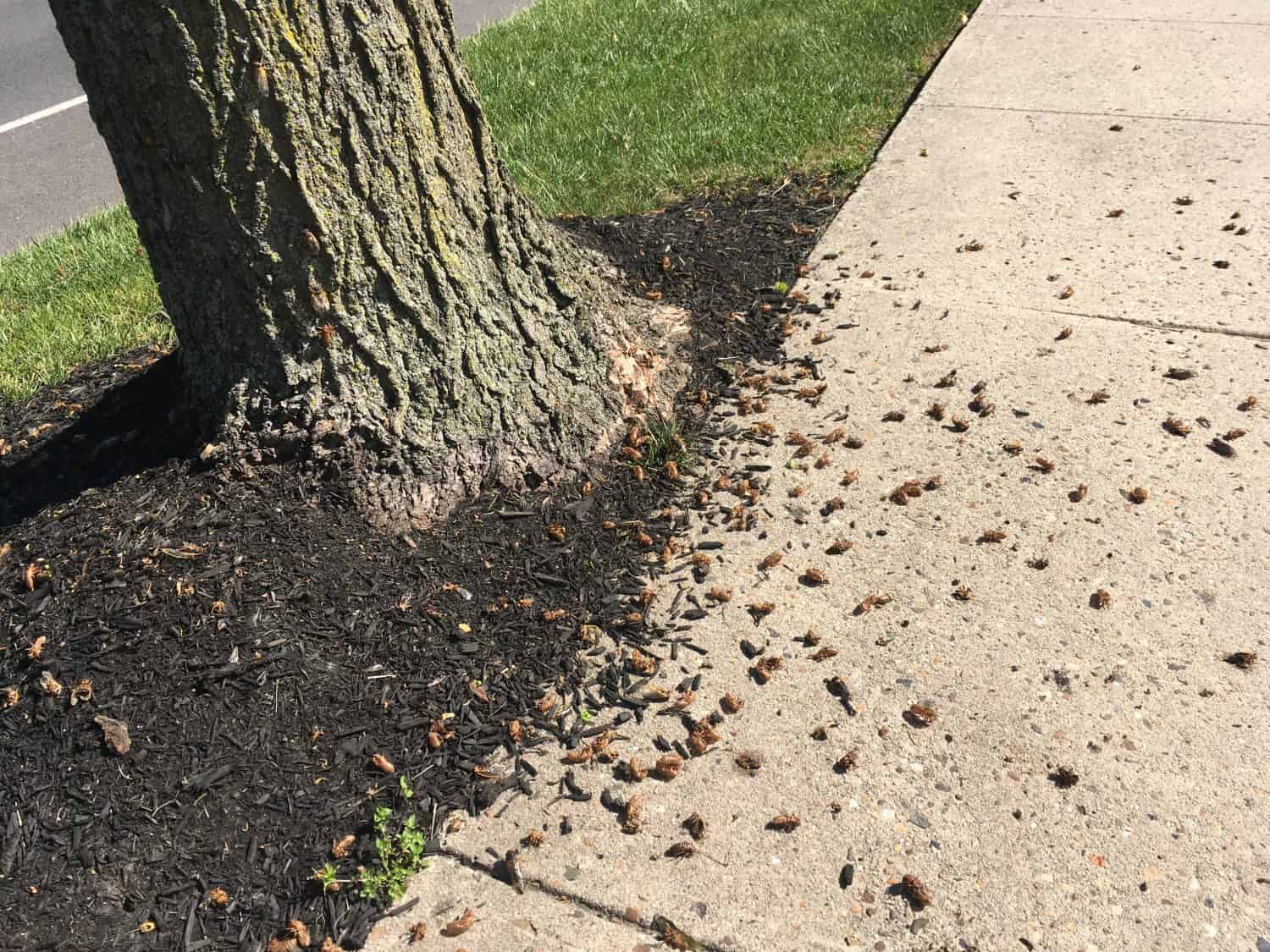
About a month after emerging, dozens of dead cicadas lay beneath a tree, completing their life cycle.
©dorkle/Shutterstock.com
The periodical cicada is one of the longest-living insects on the planet. However, most of their 13-17-year life is spent underground, feeding on the roots of trees. As ground temperatures reach 64° at a depth of 8 inches, cicadas emerge from their underground life as nymphs. Soon, they molt, abandoning their protective exoskeleton. The cicadas are vulnerable for a few hours, remaining soft and pale until their exterior hardens and gains its customary darker color. Now, their sole purpose is to mate. Males congregate in choruses to sing and attract females. After mating, females cut a groove into the bark of pencil-like branches in trees or woody shrubs. There, they deposit between 500-600 eggs. After about a month, the adult cicadas start to perish, littering the ground and tree undergrowth with decaying insect bodies. Eggs will hatch after 6-10 weeks. The newly hatched cicada broods feed off of any roots they can find. Eventually, they burrow 8-12 inches deep into the soil, securing their place until the next reemergence, whether it’s 13 or 17 years. This above-ground part of their lifecycle lasts only a few weeks, and by July, the periodical cicadas are usually gone.
Are You In?

This year’s historical cicada emergence brings tourists throughout the Midwest for a once-in-a-lifetime experience.
©shironosov/iStock via Getty Images
While cicadas can be an annoyance for some, especially if you’re in the area of this year’s overlapping broods, for others, they are an intriguing and fascinating insect. While some can’t wait for the cicadas to do their predestined duty and fade away by the beginning of July, others are planning destination trips to see this once-in-a-lifetime event involving trillions of cicadas. Yes, trillions. So put your earplugs in if you must, but come warmer temperatures, keep your eyes peeled for these winged marvels. You’ll be amazed at their natural instincts, life cycle, and, most of all, their uncanny ability to keep their calendar appointments decades apart.
The photo featured at the top of this post is © Jeff Herge/iStock via Getty Images
Thank you for reading! Have some feedback for us? Contact the AZ Animals editorial team.




